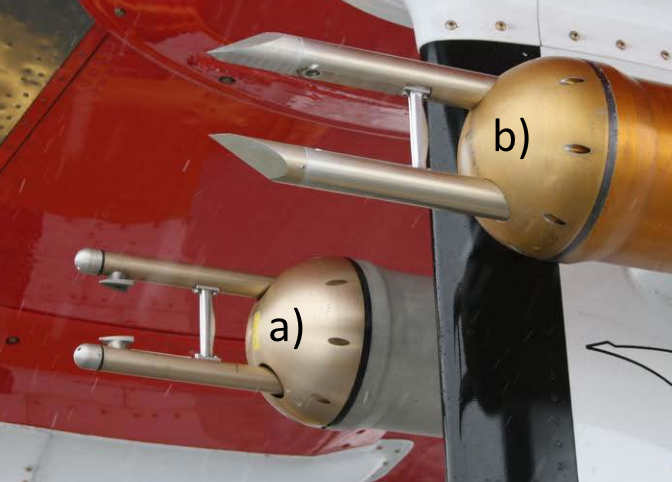Assessing Impact of Shattered Artifacts on Measured Size Distributions
Submitter
McFarquhar, Greg — University of Oklahoma
Area of research
Cloud Distributions/Characterizations
Journal Reference
N/A
Science
Model parameterizations of ice clouds have typically been derived from observations of ice particle size distributions (PSDs), collected by optical array probes mounted on the wings of aircraft. Many recent studies have shown PSDs can potentially be contaminated by particles shattering on the tips of these probes, with shattered artifacts subsequently entering the probe sample volume. Two techniques have been used to remove shattered artifacts from optical array probe data: 1) one uses an algorithm that looks at the temporal spacing between particles arriving in the sample volume, and identifies particles in close clusters as shattered artifacts; 2) the other involves modifying the probe tips in such a way that the shattered particles are swept away from the sample volume. Past studies have drawn varying conclusions as to which technique is most effective at removing shattered artifacts, and the result may well depend on the probe used, probe placement on the plane, airspeed, and attitude angles, as well as the types of particles sampled.
Impact
This study compares PSDs from two 2D Cloud Probes (2DCs), one with standard hemispheric tips, and one with Korolev tips designed to sweep away shattered artifacts from the sample volume (Figure 1), and processed with and without the use of shattered-artifact removal algorithms. Data from two field experiments, the DOE ARM Indirect and Semi-Direct Aerosol Campaign (ISDAC) and the National Science Foundation Instrumentation Development and Education in Airborne Science 2011 (IDEAS-2011) project, are used. In addition to seeing the impact of shattered artifacts on measured PSDs, the contributions of such artifacts to various ice cloud bulk properties are also examined. Since such properties are predicted in model schemes and derived from remote-sensing retrieval algorithms, knowledge of such impacts is important. As a consequence, an estimate of the bias was obtained due to shattering in historical data sets, collected by 2DCs before shattered-artifact removal algorithms and anti-shatter tips were commonly used. The ratio of the number concentration from the 2DC with standard tips to the 2DC with modified tips (Ns/Nm) was examined for several different size ranges. Figure 2a shows the ratio was higher in the presence of graupel and increased with the median mass diameter (Dmm), with medians up to seven for Dmm as large as 2000 micrometers. Similar plots constructed for other size ranges indicated PSDs from 2DCs, with standard tips, were greatly contaminated by shattering for particles with maximum dimensions less than 500 μm. Further, a combination of algorithms and redesigned tips was shown to be needed to eliminate the majority of artifacts. Since lower-order moments of PSDs are dominated by concentrations of smaller particles, this shows that parameterizations of lower-order moments (i.e., number concentration) based on data collected by 2DCs with standard tips will probably have large errors. Bulk-cloud parameters derived from higher-order moments were computed from PSDs with standard and modified probe tips, and processed with and without artifact-removal algorithms. The estimate of bias due to shattering from properties derived from higher-order moments was much less than that in the number concentration. At most, a 25 percent change was seen in ice-water content, bulk extinction, single-scatter albedo, asymmetry parameter, effective radius, and mass-weighted fall speed between the standard probe tips without use of algorithms and from modified probes with or without use of algorithms. This is seen in Figure 2b, where four derivations of bulk extinction differ from the 1:1 line by 20 percent or less. Therefore, parameterizations of bulk quantities based on higher-order moments derived from older versions of 2DCs can likely continue to be used with appropriate caution.
Summary
Artifacts as large as 500 micrometers are generated from the shattering of large crystals on the standard tips of 2DC probes, and can make significant contributions to estimates of bulk-cloud parameters dominated by lower-order moments of the PSDs. The conditions under which shattering is more prominent, namely the presence of larger particles or in rimed conditions, were identified using data collected in mid-latitude and arctic clouds. However, bulk properties based on higher-order moments were amplified by, at most, 25 percent from the presence of artifacts. Therefore, bulk properties based on higher-order moments (i.e., bulk extinction, ice-water content, effective radius, etc.) derived from 2DCs with standard tips can be used in model and retrieval parameterization schemes provided the uncertainty required is 25 percent or more.


